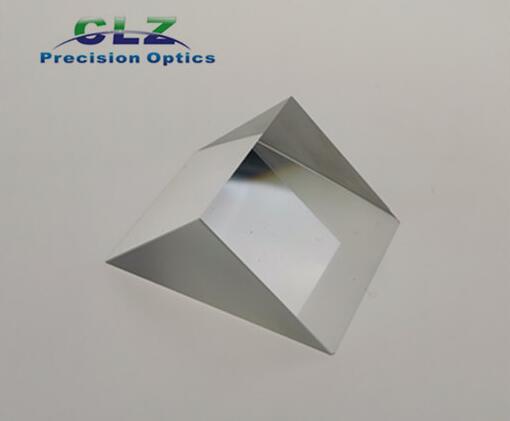In the Spotlight: Light Guides and Prisms
Jan. 25, 2022
What is a light guide?
Light guides are also known by a variety of names. Familiar titles include Lightpipes, Homogenizing Rods and Homogenizers, to name a few. These components are typically rectangular in shape and are designed so that light travels parallel to their width. Here, light enters through the bottom of the optical element and exits from the top edge using total internal reflection (TIR). Essentially, they are used to improve the uniformity of the light source, and they are often used in applications where size limits the use of light bulbs. Typically, light guides are manufactured in a range of substrates - depending, of course, on the wavelength of the application. In general, this includes BK7 (or equivalent), UV fused silica or sapphire.
Researchers are now investigating 3D methods for producing photoconductors. For example, one study explored the prospect of 3D printing geometrically complex photoconductors for scintillation detectors (using a spectrometer to measure spectral transmittance). The results of the experiment found that there is "potential" to build these components for scintillation detectors in the future. Nevertheless, the study did determine that "continued advances in materials and methods may improve the optical performance of 3D printed structures. As a result, there may be opportunities for 3D printed production of selected optical components sometime in the future.
What are the uses of photoconductors?
Photoconductors have a variety of uses. Perhaps one of the most prominent applications is intense pulsed light (IPL), a laser-like, non-surgical treatment that improves the color and texture of the skin. Specifically for this application, light guides are regularly paired with filters to focus specific wavelengths onto the skin for treatment.
Another area where light guides can be found is in the automotive industry, where they are used, for example, in the backlighting of indicators and displays. Further operations include biomedical devices, communication devices and other lighting systems.
Recent projects using light guides
Returning to the previously mentioned development of 3D printed light guides, our example below is also based on the study of scintillators (conversion of high-energy radiation into near or visible light). In this case, the optical element is formed in the form of a spacer as part of a study to improve the light collection efficiency of a "pixelated scintillator-based Y-ray imager". Here, the researchers used 1 mm and 2 mm thick light guides and found that they could "correlate the improved resolution and position performance with the superior light collection efficiency of a 1 mm thick light guide2.
Prisms
Prisms are widely recognized for their feature on the cover of Pink Floyd's "Dark Side of the Moon" album. However, we cannot credit the melodic rock band with the famous historical prism experiment - as creative as they were. Science buffs will know that we must thank the famous British mathematician, physicist and astronomer Sir Isaac Newton for the benefits of prisms and how we use them today. Sir Isaac Newton was, of course, the first to confirm that white light is made up of a spectrum that we can see.
What are prisms?
Now that we know a little more about their origin, let's explore their formation. A standard prism has a flat surface that refracts light and is typically used to disperse white light into its fractional wavelengths. That is, some classifications adjust the position of the image by shifting, rotating or offsetting the light beam. These variations are used for different applications and research-based arrangements, which we will explore further below. In particular, at CLZ we offer 13 different styles.
These include (but are not limited to) the following types of prisms.
✱ Amicus Roof
✱ Equilateral
✱ Perlin-Broca
✱ Ultraviolet type
✱ Infrared type
✱ Angular cubic
✱ Fresnel
✱ Bolo
✱ Wedge
✱ Deviated pentagon
✱ Reflective rhombus
✱ Dove
✱ Littrow
✱ Right angle
What is the use of a prism?
These optical components are everywhere. You can find prisms anywhere, from periscopes and binoculars to laser and beam-based combination applications. More specifically, Amici types are commonly used as telescope eyepieces, endoscopes, and silhouette projectors. In contrast, the Dove type is valuable as an image rotator in fields such as astronomy and interferometry.
Recent projects using prisms
Let's start with the Pellin-Broca style. 2021, this type of prism was used with a dielectric mirror on a BK7 substrate for a synchronously pumped optical parametric oscillator (OPO) - a laser-like source that typically includes an optical resonator and a nonlinear optical crystal. The results showed that this setup yielded "tunable wavelengths in the 1100 to 1350 nm range, suitable for basic multiphoton applications. However, the researchers did later note that changing the substrate from BK7 to a "less dispersive substrate," such as calcium fluoride (CaF 2 ), provided "smoother tuning" among other benefits.
The future of prisms and light guides
With such a wide range of uses and implementations in ongoing experiments in many industries, we are certainly looking forward to seeing what this duo of optical components will bring next year. After research projects and mass production of established applications, CLZ offers custom prisms and light guides as part of a custom package. In addition to a comprehensive inventory catalog, CLZ's custom service ensures that all project needs are met, despite the complexity of the project.
If you are looking for quality custom optics, please contact a member of the technical sales team today.



















